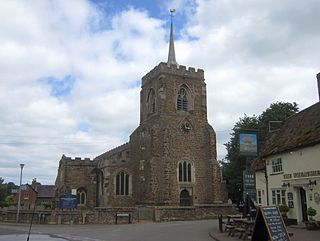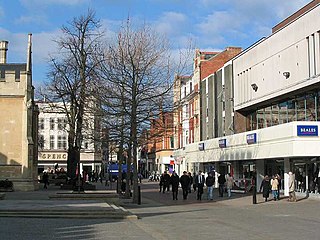
John Bunyan was an English writer and Puritan preacher. He is best remembered as the author of the Christian allegory The Pilgrim's Progress, which also became an influential literary model. In addition to The Pilgrim's Progress, Bunyan wrote nearly sixty titles, many of them expanded sermons.

Bedfordshire is a ceremonial county in the East of England. It is bordered by Northamptonshire to the north, Cambridgeshire to the north-east, Hertfordshire to the south and the south-east, and Buckinghamshire to the west. The largest settlement is Luton (225,262), and Bedford is the county town.

Bedford is a market town in Bedfordshire, England. At the 2011 Census, the population of its urban area, including Kempston and Biddenham, was 106,940. Bedford is also the county town of Bedfordshire and seat of the Borough of Bedford, a unitary authority that includes a significant rural area.

The Pilgrim's Progress from This World, to That Which Is to Come is a 1678 Christian allegory written by John Bunyan. It is regarded as one of the most significant works of theological fiction in English literature and a progenitor of the narrative aspect of Christian media. It has been translated into more than 200 languages and has never been out of print. It appeared in Dutch in 1681, in German in 1703 and in Swedish in 1727. The first North American edition was issued in 1681. It has also been cited as the first novel written in English. According to literary editor Robert McCrum, "there's no book in English, apart from the Bible, to equal Bunyan's masterpiece for the range of its readership, or its influence on writers as diverse as William Hogarth, C. S. Lewis, Nathaniel Hawthorne, Herman Melville, Charles Dickens, Louisa May Alcott, George Bernard Shaw, William Thackeray, Charlotte Bronte, Mark Twain, John Steinbeck and Enid Blyton." The lyrics of the hymn "To be a Pilgrim" are based on the novel.

Gamlingay is a village and civil parish in the South Cambridgeshire district of Cambridgeshire, England about 14 miles (23 km) west southwest of Cambridge.

Houghton House is a ruined mansion house in the parish of Houghton Conquest, Bedfordshire. It is a Grade I listed building, positioned above the surrounding countryside, and commands excellent views. Built from 1615 to 1621, it is said that the house was the model for House Beautiful in John Bunyan's The Pilgrim's Progress (1678). It was abandoned in 1794 and stripped of its interiors and roof for sale as building supplies. Today the property is owned by English Heritage, and is open to free public access during daylight hours.

Harlington is a village and civil parish located in Bedfordshire, England, near the M1 motorway. The nearest town is Flitwick about 3 miles (4.8 km) to the north.

The Slough of Despond is a fictional bog in John Bunyan's allegory The Pilgrim's Progress, into which the protagonist Christian sinks under the weight of his sins and his sense of guilt for them.
The Pilgrim's Progress is an opera by Ralph Vaughan Williams, based on John Bunyan's 1678 allegory The Pilgrim's Progress. The composer himself described the work as a 'Morality' rather than an opera. Nonetheless, he intended the work to be performed on stage, rather than in a church or cathedral. Vaughan Williams himself prepared the libretto, with interpolations from the Bible and also text from his second wife, Ursula Wood. His changes to the story included altering the name of the central character from 'Christian' to 'Pilgrim', so as to universalise the spiritual message.

Elstow is a village and civil parish in the Borough of Bedford, Bedfordshire, England, about 2 miles (3.2 km) south of Bedford town centre.

"To Be a Pilgrim", also known as "He Who Would Valiant Be", is an English Christian hymn using words of John Bunyan in The Pilgrim's Progress, first appearing in Part 2 of The Pilgrim's Progress, written in 1684. An alternative variation of the words was produced by Percy Dearmer in 1906.

Elstow Abbey was a monastery for Benedictine nuns in Elstow, Bedfordshire, England. It was founded c.1075 by Judith, Countess of Huntingdon, a niece of William the Conqueror, and therefore is classed as a royal foundation.

Cauldwell is an electoral ward and area within the town of Bedford, England.
John Brown (1830–1922) was a British theologian, historian, and pastor.

Castle is an electoral ward and area of Bedford, Bedfordshire, England.

The Higgins Art Gallery & Museum is the principal art gallery and museum in Bedford, Bedfordshire, England, run by Bedford Borough Council and the trustees of the Cecil Higgins Collection.

A bronze statue of John Bunyan stands on St Peter's Green, Bedford, England. The statue was sculpted by Sir Joseph Edgar Boehm, it was erected in 1874, and unveiled on 10 June of that year. The statue was commissioned by the Ninth Duke of Bedford and presented by him to Bedford town.
Elstow is a civil parish in Bedford, Bedfordshire, England. It contains 31 listed buildings that are recorded in the National Heritage List for England. Of these, three are listed at Grade I, two are listed at Grade II*, the middle of the three grades, and the others are at Grade II, the lowest grade. The parish adjoins the large town of Bedford. Almost all the listed buildings are houses. Also listed are a church, a moot hall, two public houses and the ruined Hillersdon mansion.

The Moot Hall, also known as the Green House, is a medieval structure on The Green in Elstow, Bedfordshire, England. The structure, which currently operates as a museum, is a Grade II* listed building.


















